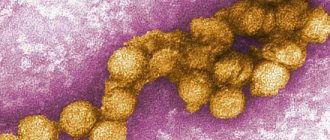Conjunctivitis is a disease caused by inflammation of the eye conjunctiva. As a rule, the causes of conjunctivitis are an allergic reaction or an infection. Viral conjunctivitis most often occurs as a result of herpetic or adenovirus infection, which is the “culprit” of inflammation of the upper respiratory tract - bronchitis.
Today, viral conjunctivitis is the most common eye disease and often becomes epidemic. This pathology easily affects large groups of people, since it can be transmitted by airborne droplets. Often, to become infected, it is enough to touch your eyes with dirty hands or use someone else’s handkerchief or towel.
Causes
Viral conjunctivitis is caused by viral infections, mainly adenoviruses. As a rule, the disease is provoked by hospital infections spread by airborne droplets or contact. Transmission of viral conjunctivitis occurs through contact with infected nasal discharge or tears of an already sick person. Symptoms usually appear after a week.
Viral conjunctivitis often develops against the background of colds and can be accompanied by inflammation of the lymph nodes, as well as a sore throat.
Redness and itching in the eyes: what to do?
At the first signs of conjunctivitis, you should immediately consult an ophthalmologist. But the opportunity to visit a specialist “here and now” is not always possible. Since the disease can be contagious, precautions must be taken.
Hygiene rules before visiting a doctor:
- Don't rub your eyes. Often, infectious and bacterial conjunctivitis first affects one eye and spreads through the hands to the other. If the itching is unbearable, scratch the eye through a bandage or clean cloth, throw it away and wash your hands.
- Don't wash your face. Wipe your cheeks, neck and forehead with a damp cloth, and your eyes with a sterile gauze pad. There is a separate one for each eye.
The exception is contact with chemicals in the eyes. In this case, on the contrary, rinse your eyes generously with boiled water.
- Avoid glasses and contact lenses until diagnosis.
- Wash your face towel, otherwise you risk infecting your family.
- If fluid flows from your eyes, wipe them with boiled water using a sterile bandage. Do not use cotton wool, as the lint from it can make the situation worse. You should wipe your eyes from the inner corners to the outer ones. A separate gauze swab for each eye; do not put it in a cup of water. Throw away after use.
- Do not visit the pool, gym, avoid close contact with people.
Noticed redness, tearing and itching of your eyes? Do not wait for it to “go away on its own” and do not self-medicate.
Herpetic conjunctivitis
This form of inflammation develops under the influence of the herpes simplex virus. Typically, the disease affects children and has a sluggish and erased course. Almost always, the pathological process accompanies the appearance of herpetic blisters in the eyelid area.
Herpetic conjunctivitis has the following forms:
- catarrhal (occurs easily, with mild symptoms);
- follicular (with the formation of blisters on the skin);
- vesicular-ulcerative (with the formation of small ulcers and erosions).
How does infection occur?
Infection with adenoviral conjunctivitis occurs through airborne droplets from coughing and sneezing, and less often when the pathogen comes into direct contact with the mucous membrane of the eyes.
The disease begins with severe nasopharyngitis and increased body temperature. During the second wave of temperature rise, symptoms of conjunctivitis appear first in one eye, and after 1-3 days in the other. A scanty transparent mucous discharge appears. The conjunctiva of the eyelids and transitional folds is hyperemic, edematous, with a greater or lesser follicular reaction and with the formation of easily removable films on the conjunctiva of the eyelids (usually in children). Regional lymph nodes enlarge. The sensitivity of the cornea is reduced.
How long does adenoviral conjunctivitis last? The symptoms of keratitis usually disappear completely upon recovery, which occurs within 2-4 weeks.
Adenoviral conjunctivitis
This form of the disease is often called pharyngoconjunctival fever, due to the fact that in addition to eye damage, pharyngitis occurs, which is accompanied by high fever. Later, the clinical picture is complemented by redness and swelling of the eyelids, and the discharge of clear mucus from the eyes.
Adenoviral conjunctivitis has the following forms:
- catarrhal (with mild symptoms and a small amount of mucus discharge);
- membranous (when a thin film forms on the mucous membrane of the eyes, when removed, a bleeding surface is revealed);
- follicular (with the appearance of bubbles of various sizes on the surface of the eye mucosa).
Conjunctival dystrophy
Pinguecula (wen)
Pinguecula is a limited thickening of the conjunctiva that appears in the area of the inner edge of the cornea.
It occurs in older people as a result of eye irritation by external factors. The pathology may look like a small cosmetic defect. Removed in rare cases, at the request of the patient.
Pterygium
Pterygium (or pterygoid pleura) is an analogue of the mucous membrane of the eyeball, has a triangular shape and grows into the surface of the cornea from the side of the nose. The reason is mechanical, chemical irritants, long exposure to the sun without dark glasses.
The non-progressive form of pterygium does not require surgical treatment.
The progressive form of the pterygoid pleura begins to grow towards the center of the eye. Due to this growth, the following symptoms appear: redness and irritation of the eye, watery eyes, decreased vision due to astigmatism. In such a situation, surgery is necessary.
1 Diagnosis and treatment of conjunctivitis
2 Diagnosis and treatment of conjunctivitis
3 Treatment of conjunctivitis
Dry eye syndrome
Dry eye syndrome is a violation of the wetting of the surface of the eye due to changes in the quantity and quality of tear fluid, as well as rapid evaporation of the tear film.
Our eye is protected by an ultra-thin, three-layer tear film. The top oily layer allows the upper eyelid to glide over the surface of the eye and prevents the other two layers from drying out.
The middle layer (aqueous, with electrolytes) supplies the cornea with nutrients, protects the eye and flushes foreign bodies out of it.
The third mucin layer ensures the smooth surface of the cornea and maintains clear vision. Violation of the stability of the tear film leads to dryness of the surface of the conjunctiva and cornea and the appearance of dry eye syndrome.
This pathology is called the “disease of civilization”, since long hours of work at the computer, unhumidified air from air conditioners and prolonged wearing of contact lenses greatly contribute to the appearance of the disease.
Other causes of dry eye syndrome can be: endocrine disorders, pathology of the visual organs, connective tissue diseases, vitamin deficiency, and the use of certain medications.
Symptoms of dry eye syndrome:
The following signs of dry eye syndrome can be identified:
- feeling of sand in the eyes, dryness and pain (may increase at the end of the day);
- redness of the eyes;
- blurred vision that disappears when blinking;
- eye discomfort after reading or working at the computer.
Epidemic keratoconjunctivitis
The disease is considered highly contagious and can affect entire families or large groups. The causative agent is a certain type of adenovirus, and the infection itself is transmitted through household items, dirty hands and underwear. There are cases when infection occurs through ophthalmic instruments.
About a week passes from the moment of infection to the appearance of the first manifestations of the disease. The patient usually develops mild weakness, headache, and sleep disturbances. First, one eye is affected, and after some time the other eye is also involved in the process. Patients complain of the presence of “sand” in the eyes, heavy discharge from the eyes, and lacrimation occurs. The eyelids swell, the mucous membrane turns red, and a small amount of purulent mucous discharge forms in the conjunctival sac. The above symptoms are often accompanied by pain in the submandibular lymph nodes, photophobia, blurred vision, pinpoint opacities, and inflammation of the cornea. This condition can last for about two months, after which the disturbing symptoms disappear and vision is completely restored. It should be noted that a person who has suffered epidemic keratoconjunctivitis develops lifelong immunity to this disease.
Prevention
If you or your child has conjunctivitis:
- Do not touch or rub the infected eye.
- Wash your hands frequently with soap and warm water.
- Wash out any particles that get into your eyes twice a day, using a new cotton swab or paper towel each time. Afterwards, wash your hands with soap and warm water.
- Wash your bed linens, pillowcases and towels in hot water and detergent.
- Do not wear eye makeup.
- Do not share your eye cosmetics with anyone.
- Never wear another person's contact lenses.
- Wear glasses instead of contact lenses. Throw away your used lenses and make sure to wear safety glasses for all occasions.
- Don't share things like unwashed towels or glasses.
- Wash your hands after applying eye drops or ointment to your or your child's eyes.
- Do not use eye drops that you put in an infected eye and then use on an uninfected eye.
- If your child has bacterial or viral conjunctivitis, keep him or her at home until he or she recovers completely.
And most importantly, seek help from professionals! Self-treatment of such a seemingly trivial problem as conjunctivitis can lead to serious complications!
Treatment of viral conjunctivitis
The incubation period for adenoviral conjunctivitis is up to 8 days, and epidemic keratoconjunctivitis can develop in about 8 hours. When developing a treatment regimen for conjunctivitis, it is necessary to take into account the severity of the disease, plus the status of the patient's immune system. Typically, therapy for such a pathology requires the use of antiviral drugs in ointments and drops, as well as interferon. It is also necessary to prescribe multivitamin preparations in combination with herbal remedies that can stimulate the immune system, which helps strengthen the body's defenses, accelerating the healing process.
The unpleasant symptoms of viral conjunctivitis are relieved by using artificial tear eye drops and warm compresses. If signs of eye inflammation are pronounced, it is possible to use drops containing corticosteroid hormones. As a rule, the drugs of choice for the treatment of viral conjunctivitis are: Ophthalmoferon drops; products containing acyclovir, which is necessary for herpetic conjunctivitis; antibiotic drops if there is a secondary infection; artificial tear preparations to relieve symptoms.
The duration of the disease, as a rule, does not exceed three weeks, and the process of its treatment often lasts more than a month.
In the medical department, everyone can undergo examination using the most modern diagnostic equipment, and based on the results, receive advice from a highly qualified specialist. The clinic is open seven days a week and operates daily from 9 a.m. to 9 p.m. Our specialists will help identify the cause of vision loss and provide competent treatment for identified pathologies.
You can make an appointment at the Moscow Eye Clinic by calling 8 8 (499) 322-36-36 (daily from 9:00 to 21:00) or using the online registration form.
Diagnostics
A doctor can determine viral conjunctivitis during a routine examination of the patient. In order to identify the cause, the patient is interviewed about possible contact with an infected person.
To clarify the type of pathology and its causative agent, tissue cultures from the conjunctiva may be taken from the patient. Biomaterial is used for the following studies:
- cytological analysis. Shows destruction of the epithelium, hypertrophy of the nucleoli, vacuolization and formation of the nuclear envelope. With adenovirus infection, degeneration of epithelial cells is detected with vacuolization of their nuclei and chromatin disintegration. An accumulation of neutrophils and monocytes is recorded in the discharge;
- virological test;
- determining the type of cellular reaction. Polymerization helps identify viral DNA;
- sowing.
In severe cases of pathology and for the purpose of differential diagnosis, an immunological analysis is prescribed. Thanks to immunofluorescence research, specific viral antigens are found in the smear. The adenoviral type of pathology is indicated by an increase in antibody titers by 4 or more times.
If photophobia develops, the eyes are examined using a slit lamp. Biomicroscopy of the eyes is carried out in a dark room. The device is installed on a special table and screwed in place. It is equipped with high-quality optical systems that help to closely examine the cornea, lens, anterior chamber and vitreous body. Such an examination helps to promptly identify the presence of complications. Using the handle, the lamp can be stirred and fixed in the desired position.
Eye biomicroscopy involves the following steps:
- the patient and the doctor sit opposite each other;
- the beam is directed into the patient’s eye to examine internal structures;
- if necessary, the patient is asked to focus his vision at certain points.
To examine the lens, the doctor first instills eye drops.
The following situations are contraindications to the procedure:
- alcohol or drug intoxication;
- mental and nervous disorders accompanied by aggressive behavior of the patient.
In case of epidemic ceraconjunctivitis, during the examination, pinpoint pigmentation of the mucous membrane is revealed.
To select the correct and effective treatment method, it is important to distinguish viral conjunctivitis from bacterial conjunctivitis. There are a number of signs that help make an accurate diagnosis:
- The pain in the bacterial form is more pronounced and the itching is less;
- With viral conjunctivitis, eyelashes rarely stick together, since the discharge is serous in nature. The appearance of pus is observed when a bacterial infection is associated;
- hyperemia of the mucous membrane and lacrimation are more pronounced in the viral nature of the disease;
- with bacterial conjunctivitis, inflammation is always localized in two organs of vision.
A doctor can carry out a differential diagnosis of this type using a general blood test, which will confirm or deny the presence of a bacterial infection in the body.
Treatment of conjunctivitis can be carried out on an outpatient basis, but in the following situations it is necessary to urgently consult a doctor:
- ineffectiveness of the drugs used;
- worsening symptoms;
- poor effectiveness of home treatment;
- the occurrence of conjunctivitis after contact with an infected person;
- severe pain syndrome;
- incessant itching and burning;
- development of conjunctivitis after using lenses;
- inability to independently determine the type of disease;
- the appearance of uncharacteristic symptoms.
Timely consultation with a doctor will reduce the risk of complications, among which decreased vision is especially dangerous.
- Oftalmoferon. The composition contains diphenhydramine and interferon. During the acute stage, the number of installations is 6-8 rubles/day, and as the symptoms subside, they are reduced to 1-2 rubles/day. Dosage – 1-2 drops. The only contraindication is individual intolerance. Additionally, it has an anesthetic effect;
- Aktipol. The active substance is aminobenzoic acid. In acute cases, 1-2 drops are injected into the conjunctival sac 6-8 rubles/day until complete recovery. Within 5 days after the symptoms subside, drops are administered 3 times a day. Use in therapy of children and pregnant women is possible if the expected benefit exceeds the potential risk;
- Poludan. Used as an immunomodulator. The dosage and duration of treatment are identical to ophthalmoferon drops;
- Okoferon. Used mainly for herpes infections. The effect on the body of children and pregnant women has not been studied. 2 drops of Okoferon are injected into the affected eye every 2 hours (at least 6 times). Gradually reduce the dosage to 1 drop.
To increase the effectiveness of treatment, 2 rubles are placed behind the eyelid of the affected eye. per day antiviral drugs in the form of ointments:
- Bonafton;
- Florenal;
- Terbophenol ointment.
When treating the herpetic form of conjunctivitis, Acyclovir, Zovirax, Virolex are usually used. The ointment should only be applied with clean hands. Some manufacturers produce drugs with a special glass rod, which makes the procedure easier. For extensive lesions, oral NSAIDs and immunomodulators are additionally prescribed.
Due to the high risk of bacterial infection, doctors often carry out preventive measures, including the use of antibacterial eye drops and ointments. Such drugs include:
- Phloxal;
- Torbex;
- Tetracycline and Erythromycin ointments.
The duration of prophylaxis is determined by the doctor, usually its duration does not exceed 7 days.
Before starting to use any drug, doctors recommend conducting a provocative test to exclude the development of an allergic reaction. Apply a few drops or a small portion of ointment to the skin of the back of the wrist and wait 20-30 minutes. If redness, rash, burning and itching appear in this area, then the medicine must be replaced with another.
In order to accelerate the regeneration of the affected organ, drug therapy is combined with the procedure of washing the mucous membrane. It helps clear the eye of dust and soothe irritated conjunctiva.
Use solutions of Furacilin, sodium chloride, boric acid, Miramistin or Chlorhexidine.
Drug therapy
Most often, treatment of adenoviral conjunctivitis in adults is carried out using the following drugs, drops and ointments:
- Tebrofen. Antiviral drug. Available in the form of drops or eye ointment.
- Phloxal. The basis of the drug is the antimicrobial agent ofloxacin.
- Albucid. Broad spectrum antimicrobial eye drops.
- Interferon. Immunomodulating antiviral agent.
- Tobrex. Antimicrobial drops. Can be used from the first days of a child's life.
- Poludan. A drug that stimulates the production of interferon.
- Florenal. Designed to neutralize the virus. Particularly effective against Herpessimplex.
- Vitabact. A drug with aseptic properties. Can be used in infants.
Treatment is carried out under the strict supervision of a doctor. An incorrectly selected remedy can only worsen the situation.
Classification
Depending on the symptoms, the following forms of adenoviral conjunctivitis are distinguished:
- Membranous - characterized by the formation of grayish-white films in the area of the eye shell; they are easily removed using cotton swabs. If the film is located too tightly to the conjunctiva, bleeding may occur when it is removed. At the site of mucosal deformation, scars or small compactions are visible, but they quickly resolve after complete recovery. A severe form of the disease is accompanied by fever and high temperature.
- Follicular - this type of inflammation of the conjunctiva is recognized by the numerous blistering rashes present on the loosened mucous membrane of the eye. They can be different in size: both large and very small. Visually, these are translucent gelatinous capsules. Especially many follicles cover the transitional fold. The follicular form is very similar to trachoma in the initial stage of development. But errors in diagnosis are very rare, since it is not characterized by manifestations of nasopharyngitis and febrile conditions. In addition, trachoma rashes are located on the conjunctiva of the upper eyelid.
- Catarrhal - inflammation and redness are minor, discharge is scanty. The disease is mild, takes about 7 days, and there are no complications.
It is important to immediately consult a doctor when the first signs of pathology appear for diagnosis, confirmation or refutation of the diagnosis.
Complications and prognosis
Late or improper treatment of adenoviral conjunctivitis can lead to the development of quite severe complications, namely:
- development of chronic recurrent conjunctivitis;
- keratoconjunctivitis (spread of inflammation to the cornea);
- addition of a secondary (bacterial) infection;
- development of dry eye syndrome;
- iridocyclitis (damage to the iris and ciliary body of the eye).
The prognosis is favorable: usually the disease ends with complete clinical recovery in 2-4 weeks. When dry eye syndrome develops, long-term use of tear substitutes is required.









